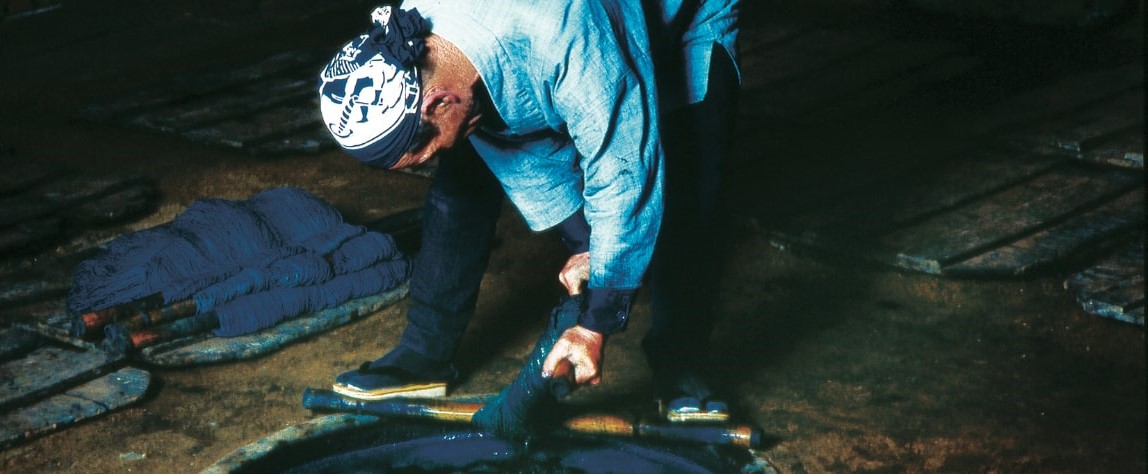From dye making to trading
Creating a path for taking local products to the world
Moriroku's history originates from the Japanese indigo plant, which has been treasured for centuries as a source of medicinal herbs and a beautiful blue dye. During Japan's Edo period (1603 to 1868), indigo dye was widely used by people for everyday items like clothing and shop curtains. A British chemist visiting Japan in 1875 noticed the vivid color of such items everywhere he traveled, praising it as "Japan blue." These indigo adorned townscapes would not have materialized without Moriroku.
Taking local goods across the country to the capital
Moriroku was founded in Shikoku, one of Japan's five main islands, in an area known as Awa at that time (now Tokushima Prefecture). The local area had a thriving indigo harvesting and dyeing industry. In 1663, Moriroku's founder began selling easily transportable balls of dried, fermented indigo leaves for dyeing as well as a fertilizer for cultivating indigo plants. The business sold dried sardines as fertilizer to indigo farmers and received the balls of leaves as payments. This mutually beneficial system laid the foundation for Moriroku's history of over 360 years.
The business began growing from that time onward, selling products in other areas of the country and establishing wholesale shops and factories. Moriroku opened a shop in Edo (now Tokyo) in 1853 as Japan began opening up to the world following the arrival of a U.S. navy fleet in the same year. Inexpensive fabrics from India were soon imported, increasing demand for indigo dye. Envisioning a bright future for indigo-dyed products, Moriroku responded to this opportunity by expanding its business across the country.
-

Indigo worn by everyone in Edo times: With the mass-production of cotton thread and fabric, indigo dye was commonly used to make fabric for everyday items and garments from work clothes to formal wear, as well as curtains traditionally hung over shop entrances. Following a ban on luxury items made of silk, indigo-dyed goods became rooted in the daily lives of people throughout the country.
Evolving towards a modern chemical trading company
Looking beyond Japan, Moriroku aspired to take its products overseas. International interest in Japan had grown rapidly, especially in France, following the Paris World's Fair in 1867. Japanese art and design became very popular in the 1870s, inspiring a trend known as Japonism. In cooperation with Mitsui, a major Japanese trading company, Moriroku traveled to France to exhibit Awa indigo-dyed goods at the 1878 Paris World's Fair. Afterwards, Moriroku's dyed products were sold at Mitsui's store in Paris.
-

The 1878 Paris World's Fair: Held for the third time in Paris, the 1878 World's Fair showcased rapidly developing inventions and technologies of the era. Among the exhibits, an electric powered megaphone and phonograph invented by Thomas Edison were displayed.
Over the years, however, Moriroku faced new challenges. In the second half of the century, indigo dye made in Awa was being replaced by inexpensive and attractive indigo dye imported from India. Seeing this as an opportunity, Moriroku began purchasing Indian dye products from trading companies in Yokohama, eventually handling a large amount of all imported Indian dye in Japan. Then in the 1890s, a method for mass-producing synthetic indigo dye was developed in Germany. Recognizing that the era of synthetic products had begun, Moriroku acquired the exclusive selling rights for synthetic indigo dye from the German firm, Hoechst Dye Works, in 1904. Following more growth, Moriroku reorganized as a joint-stock company in 1916 and continued to evolve as a chemical trading business.
Over its history, Moriroku was always one step ahead of market trends as it shifted from selling indigo dye from Awa to importing Indian and then synthetic indigo dyes. Taking local goods from Awa to Edo, and then from Japan to the world stage, the company's activities and aspirations continued to broaden. This pioneering spirit has been a driving force behind Moriroku's steady growth as a leading chemical trading company in Japan. Today, Moriroku Holdings is one of the longest established companies listed on the Tokyo Stock Exchange, and the Moriroku Group continues to build on its history of over 360 years to lead the way in the future.









